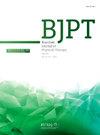心血管物理治疗ASSOBRAFIR临床实践指南:心力衰竭门诊康复项目中基于运动的干预
IF 3.2
3区 医学
Q1 ORTHOPEDICS
引用次数: 0
摘要
运动训练是心力衰竭(HF)患者心血管康复计划的核心组成部分。在巴西,物理治疗师经常提供康复干预。鉴于心力衰竭临床管理的进步和各种康复方法,在心血管康复计划中标准化运动训练是必不可少的。目的为保留左室射血分数或降低左室射血分数的心衰患者门诊心血管康复提供运动训练(ET)的循证建议。方法指南小组遵循指南国际网络(GIN)和研究与评估指南评估(AGREE-II)的原则,以确保方法的严谨性。建议分级评估、发展和评价(GRADE)方法用于评估证据的确定性(CoE),并针对临床稳定的心衰门诊患者的监督ET的关键问题制定建议。通过对2009年以来发表的随机临床试验的荟萃分析来评估治疗效果。结果:指导小组建议:高强度间歇训练与中强度连续训练相当(条件推荐[CoR],低CoE);2. 中等强度阻力训练比低强度阻力训练更有效(CoR,非常低的CoE);3. 高强度吸气肌训练(IMT)比低强度吸气肌训练(CoR,非常低的CoE)更有效;4 a。神经肌肉电刺激(NMES)比NMES安慰剂或常规活动(CoR,低CoE)更有效。4 b。除了有氧训练外,NMES并不比单纯有氧训练更有效(CoR,低CoE)。结论这些建议为心衰患者门诊心血管康复项目提供了有价值的指导。本文章由计算机程序翻译,如有差异,请以英文原文为准。
ASSOBRAFIR clinical practice guidelines in cardiovascular physical therapy: Exercise-based interventions in outpatient rehabilitation programs for heart failure
Background
Exercise training is a core component of cardiovascular rehabilitation programs for patients with heart failure (HF). In Brazil, physical therapists frequently deliver rehabilitation interventions. Given heart failure clinical management advancements and varied rehabilitation approaches, standardizing exercise training within cardiovascular rehabilitation programs is essential.
Objective
To provide evidence-based recommendations for structuring exercise training (ET) in outpatient cardiovascular rehabilitation with HF, whether with preserved or reduced left ventricular ejection fraction.
Methods
The Guideline Panel followed the principles of the Guidelines International Network (GIN) and the Appraisal of Guidelines for Research & Evaluation (AGREE-II) to ensure methodological rigor. The Grading of Recommendations Assessment, Development, and Evaluation (GRADE) approach was used to assess the certainty of evidence (CoE) and to formulate recommendations for key questions regarding supervised ET in clinically stable outpatients with HF. Treatment effects were assessed through meta-analyses of randomized clinical trials published since 2009.
Results
The Guideline Panel suggests: 1. High-intensity interval training and moderate-intensity continuous training are equivalent (conditional recommendation [CoR], low CoE); 2. Moderate-intensity resistance training is more effective than low-intensity resistance training (CoR, very low CoE); 3. High-intensity inspiratory muscle training (IMT) is more effective than low-intensity IMT (CoR, very low CoE); 4a. Neuromuscular electrical stimulation (NMES) is more effective than NMES placebo or usual activities (CoR, low CoE). 4b. NMES, in addition to aerobic training, is not more effective than aerobic training alone (CoR, low CoE).
Conclusion
These recommendations provide valuable guidance for delivering exercise-based interventions to outpatient cardiovascular rehabilitation programs in heart failure patients.
求助全文
通过发布文献求助,成功后即可免费获取论文全文。
去求助
来源期刊
CiteScore
6.10
自引率
8.80%
发文量
53
审稿时长
74 days
期刊介绍:
The Brazilian Journal of Physical Therapy (BJPT) is the official publication of the Brazilian Society of Physical Therapy Research and Graduate Studies (ABRAPG-Ft). It publishes original research articles on topics related to the areas of physical therapy and rehabilitation sciences, including clinical, basic or applied studies on the assessment, prevention, and treatment of movement disorders.

 求助内容:
求助内容: 应助结果提醒方式:
应助结果提醒方式:


